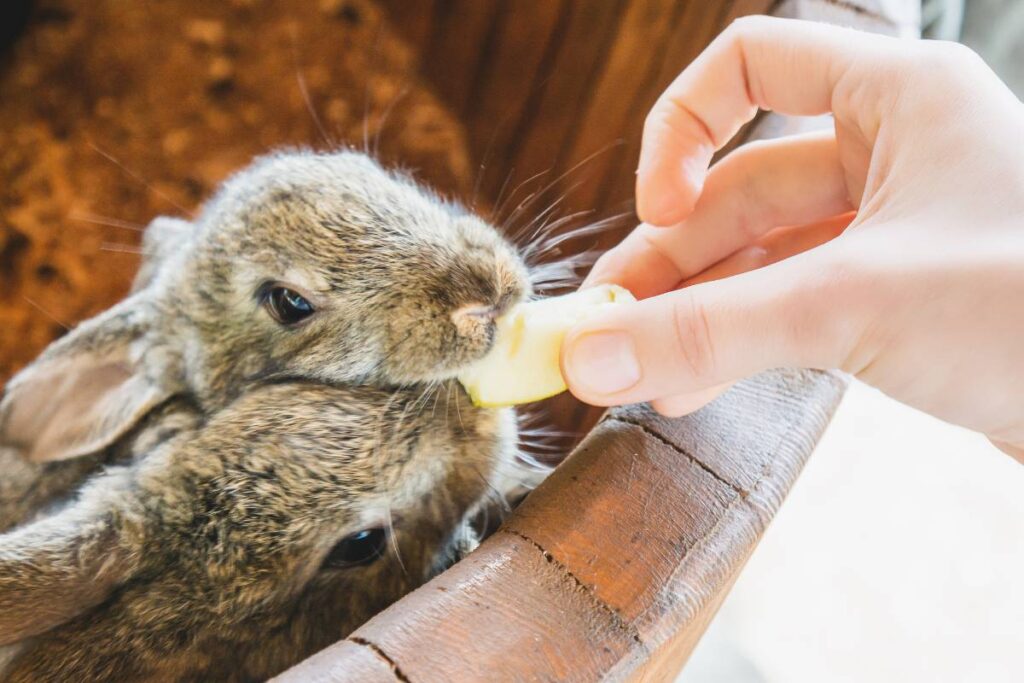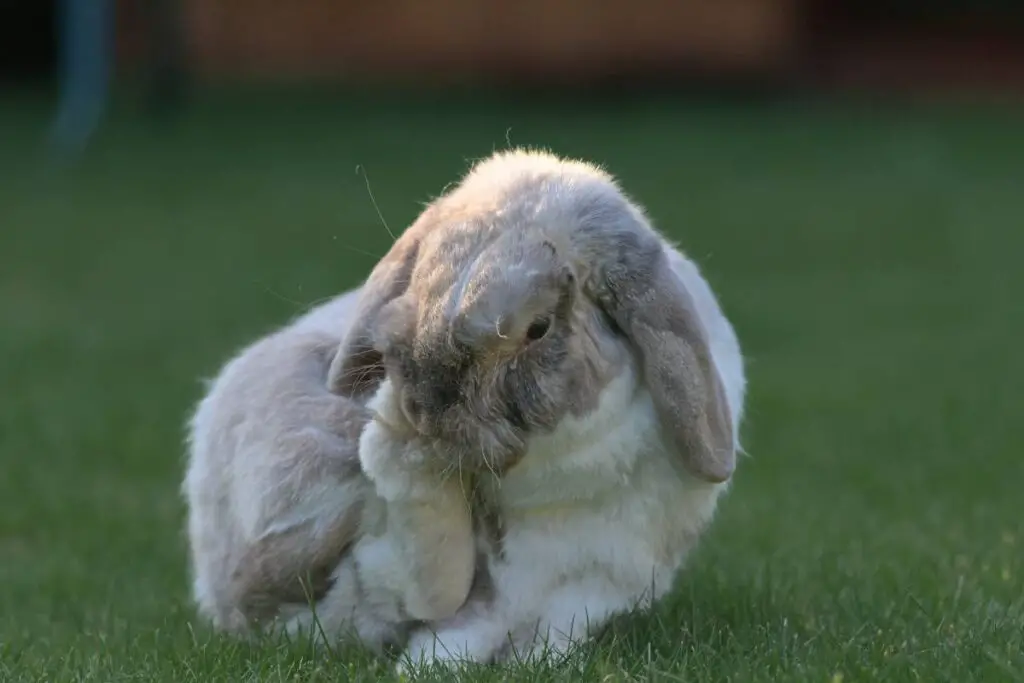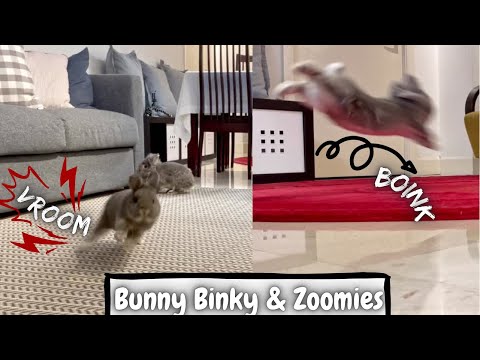If you’re a rabbit owner, you may have witnessed your furry friend performing a joyful, acrobatic leap known as a “binky.” But why do rabbits binky?
Binkying is a natural behavior for rabbits and is an expression of happiness and joy. It’s a sign that your rabbit is feeling good and is comfortable in their environment.
Binkies can be triggered by a variety of things, such as playing with toys, interacting with other rabbits or humans, or simply having a burst of energy.
In this blog post, we’ll explore the reasons why rabbits binky and what it means for their health and happiness.
We’ll also provide some tips on how to encourage binkying in your rabbit and create a fun and stimulating environment for them to thrive in.
So, if you’re a rabbit owner or considering getting a rabbit as a pet, keep reading to learn more about this adorable behavior.

Understanding Rabbit Binky
Rabbit binky is a unique behavior exhibited by rabbits which signifies their happiness and excitement. It’s a sudden, energetic movement where rabbits hop, twist, and sometimes kick their legs in the air.
Binkying is an expression of joy, and it’s pretty common to see rabbits do this when they are content or playful.
To better understand rabbit binky, it’s essential to know some of its key attributes. First, binkying typically occurs when rabbits are in a comfortable, familiar environment where they feel safe and relaxed.
When rabbits are engaged in play or exploring their surroundings, you may notice them spontaneously break into a binky. This behavior is a sign that your rabbit is feeling happy, which is an important aspect of their overall well-being.
Another interesting aspect of rabbit binky is that it’s not exclusive to a specific rabbit breed. Rabbits of all types can exhibit this behavior, sharing a common language of joy and excitement with their owners.
This makes binky an important behavioral cue to look out for, as it signals your pet’s emotional state and satisfaction with their living conditions.
When observing your rabbit binkying, take note of their surroundings and situations that seem to trigger this behavior.
If your rabbit is regularly engaging in binky, it’s a strong indication that you’re providing a suitable, enjoyable environment for them.
On the other hand, if you notice that your rabbit isn’t binkying as often as they used to, it might be an indication that they are experiencing stress or discomfort. It’s essential to pay attention to these subtle signs and make adjustments to their living conditions accordingly.
Overall, rabbit binky is a fascinating, endearing aspect of rabbit behavior that brings joy not only to the rabbits but also to their owners.
By understanding the significance of binky and observing your rabbit’s actions in different situations, you can ensure your pet remains happy and well-adjusted in their home.
Different Types of Binky
Rabbits are known for their expressive and playful behaviors, especially when they are happy and content. One particular behavior that showcases a rabbit’s happiness is the binky.
There are different types of binkies that rabbits perform, each with its unique characteristics. Here, we’ll explore some of the most common forms of binkies that you might see in your pet rabbit.
The full binky is the most recognizable type, where your rabbit will leap into the air, twisting their body and flicking their ears in the process. A full binky is a joyous expression, and it often involves a combination of jumping, leaping, and flipping. When you notice your rabbit performing a full binky, it’s a strong indicator that they are feeling content and lively.
A half binky, on the other hand, is a toned-down version of the full binky. In this case, your rabbit might only perform a slight jump without the dramatic twist or turn. Some rabbits may opt for a simple happy hop instead, which is another playful behavior that indicates happiness. While not as showy as the full binky, a half binky still signals that your rabbit is in a good mood.
The zig-zag binky is an energetic and amusing type of binky, in which your rabbit will alternate between zig-zagging across the floor and leaping into the air. This lively move can be quite entertaining to watch, and it’s an excellent sign that your rabbit is feeling playful and spirited.
Lastly, the ear flick is a more subtle expression of joy in rabbits. While not as extravagant as a full binky or zig-zag binky, the ear flick is a delightful little gesture that shows your rabbit is content and relaxed. In this behavior, your rabbit will quickly flick or twitch their ears in a subtle movement that signifies happiness.
Ultimately, observing your rabbit’s binkies and other playful behaviors is a great way to gauge their mood and overall well-being.
Make sure to provide them a stimulating environment and plenty of attention to keep them content and encourage their natural exuberance.
Remember, a happy rabbit is more likely to perform a binky and other joyful movements, so always strive to keep your furry friend comfortable and entertained.
Binkying in Contrast with Other Rabbit Behaviors
Rabbits are fascinating creatures with a diverse range of behaviors that allow them to communicate their emotions and needs.
They have the ability to convey their feelings using a combination of body language, vocalizations, and movements.
One of these distinct behaviors is binkying, which is a sudden and joyful jump that rabbits perform, often combined with mid-air twists and kicks. This behavior is a sign of happiness and excitement in rabbits.
In contrast to binkying, there are other rabbit behaviors that represent different emotions or responses to various stimuli.
For example, rabbits may freeze in place when they sense danger or a potential threat. This stillness allows them to assess their surroundings and determine their next move, whether it be to flee or confront the situation.
Rabbits also exhibit the behavior known as thumping, where they loudly stamp their rear feet on the ground.
This behavior usually signals alarm or distress in response to a perceived threat. It can also be used as a warning to other rabbits in the area, who are often sensitive to these signals.
Beyond movements like binkying, thumping, or freezing, rabbits also use their body language and head movements to convey emotions.
A prime example is the head flick, where a rabbit quickly shakes its head from side to side. This action can either indicate annoyance or even be a playful gesture, depending on the context.
Rabbits are social animals, so their body language is essential for interacting with other rabbits or even their human companions.
Head tilting, for instance, is an adorable gesture that can signify curiosity or attentiveness. Furthermore, their ear positioning and tail movement are also important indicators of a rabbit’s emotional state.
In terms of vocalizations, rabbits have several ways to express themselves.
The purr is a pleasant sound made by rabbits when they are content and relaxed. It is not quite like a cat’s purr but is similar in nature, as it signifies happiness and a sense of security.
Understanding these various rabbit behaviors and the emotions they convey can greatly enhance your relationship with your pet rabbit.
It will provide crucial insights into their needs and emotional states, ensuring that you can provide the best care and environment for your furry friend.
Reasons Rabbits Binky
Binkying is a natural expression of happiness and joy in rabbits. When your rabbit is feeling happy, they may perform a binky, which is a sudden leap into the air, often accompanied by twists and kicks.
This behavior is a visual display of their excitement and contentment.
A rabbit might binky when they experience something new or exciting, such as discovering a new toy, receiving a treat, or getting to play in a large and safe area.
They may also binky when they feel a sense of comfort, knowing they are in a secure environment, free from anxiety or potential threats.
Keeping your rabbit’s environment calm and stress-free can encourage more frequent binkying and general happiness.
In addition, rabbits may binky during playtime or when interacting with their human caretakers or other rabbits.
Playing and socializing with your rabbit can foster a sense of security and happiness, making them more likely to display these joyful leaps.
Providing your rabbit with interesting toys and enriching activities can keep them stimulated and encourage more frequent binkying.
Besides creating a positive and engaging environment for your rabbit, it’s crucial to monitor their overall health and well-being.
Making sure your rabbit has a well-balanced diet and access to clean water, as well as regular check-ups with a veterinarian, can contribute to their overall contentment.
Handling rabbit anxiety with care and understanding is also vital for their happiness, so always be vigilant in recognizing signs of anxious behavior and take appropriate measures to alleviate it.
To summarize, rabbits binky when they are feeling happy, safe, and content.
You can encourage binkying by keeping your rabbit’s environment engaging, secure, and stress-free, providing them with enriching activities and toys, and ensuring their overall health is well-managed.
By doing so, you can enjoy the delightful sight of your rabbit’s joyful leaps and keep them happy in your care.
How Owners Can Encourage a Binky

As a pet rabbit owner, you may want to see your rabbit binky more often – a sign of joy and happiness in your furry friend.
Encouraging binkies can be achieved through several strategies, focusing on providing a stimulating environment and engaging in playtime.
In this section, we’ll discuss a few ways to encourage your rabbit to binky.
Firstly, provide your rabbit with safe and entertaining toys to explore and interact with. This will keep them physically and mentally stimulated, which can lead to a happy bunny performing binkies.
Toys can be store-bought or homemade and should be chosen according to the preferences and needs of your rabbit. Some popular toys include cardboard boxes, paper towel rolls, and hard plastic baby toys.
Additionally, dedicate time each day for interactive playtime with your rabbit. This can help strengthen your bond, increase trust, and keep your rabbit happy.
You’ll notice that as your bond grows, your rabbit will be more likely to binky around you. Some playtime activities involve using toys, teaching tricks, or exploring new environments together.
It’s essential to be patient and gentle during play sessions to foster trust and encourage your rabbit to express themselves freely.
Creating a safe and spacious environment for your rabbit is crucial. Provide ample space for your rabbit to stretch, hop, and perform binkies.
It’s also important to offer hiding spots and quiet areas for your rabbit to escape when feeling stressed or overwhelmed. A calm, secure environment can enhance your rabbit’s happiness and make it more likely for them to binky.
Lastly, ensure your rabbit’s other needs are met to create a healthy foundation for happiness. This includes providing a balanced diet, proper grooming, and regular veterinary checkups.
A healthy rabbit is more likely to express joy through binkies.
By focusing on these strategies, you can help create an environment that encourages your pet rabbit to binky and enjoy their life to the fullest.
Health and Binkying
Binkying is a behavior exhibited by rabbits when they are happy and in good health. During a binky, your rabbit will jump into the air, twist their body, and kick their hind legs.
This energetic action is a sign that your rabbit is feeling content and enjoying their environment. Binkying often occurs in rabbits that are given proper care, attention, and space to move around.
A healthy rabbit is more likely to binky, as it requires physical strength and agility. To make sure your rabbit is in good health, monitor their diet, grooming habits, and fecal outputs.
Regularly check the appearance of their poop, as it can be an indicator of a healthy digestive system. Learn what normal rabbit poop looks like, and pay attention to any changes.
Rabbits need ample space to hop, run, and binky. Providing your rabbit with a safe and secure area for exercise and play is essential for their overall well-being.
Discover ways to ensure your rabbit gets enough exercise to keep them in top shape. Healthy rabbits will have strong hind legs and an ideal body weight.
Maintaining your rabbit’s good health also means being attentive to potential illnesses. Regularly observe your rabbit for any signs of illness or injury.
Learn how to identify rabbit sickness and seek veterinary assistance promptly if needed. For a comprehensive list of common rabbit illnesses and their symptoms, refer to this guide.
Keep in mind that an overweight rabbit may struggle to binky and might be at risk for other health problems. Monitoring your rabbit’s weight and providing a balanced diet can help prevent obesity.
In addition, be aware of your rabbit’s grooming habits and address any issues they may be experiencing, such as a broken or fallen-off nail. Regular grooming helps maintain health and encourages binkying.
In conclusion, a binky is a sign of happiness and good health in rabbits. By providing proper care, exercise, and a balanced diet, you can support your rabbit’s well-being and create an environment that encourages this joyful behavior.
Binkying in Pet and Wild Rabbits
Binkying is a fascinating and exciting behavior exhibited by both wild rabbits and domesticated pet rabbits. It involves a spirited, spontaneous jump into the air, often accompanied by a twist or flick of the body.
This behavior is a clear indication of a happy and healthy rabbit. Binkying is a way for rabbits to express their joy, excitement, or even a burst of energy. So, when you see your pet rabbit performing a binky, it’s a great sign that they’re feeling content in their environment.
Both wild and domesticated rabbits share a crepuscular lifestyle, meaning they are most active during the dawn and dusk hours.
This is an adaptation that helps wild rabbits to avoid predators. In your pet rabbit’s case, they may also exhibit binkying and other active behaviors most often during these times.
Understanding a rabbit’s crepuscular tendencies can help you provide an ideal environment for your pet rabbit, allowing them ample opportunity to binky to their heart’s content.
Wild rabbits are known to be more reserved and cautious due to their constant need to be aware of potential threats. However, they too exhibit binkying behavior when they feel safe and secure.
Pet rabbits, on the other hand, often have the luxury of a safer environment, which may contribute to more frequent binkying occurrences.
Nonetheless, ensuring your pet rabbit feels safe and comfortable in their environment is crucial to supporting their overall well-being and propensity for binkying.
It is essential to provide proper living conditions for your pet rabbit, including adequate space for them to run, jump, and perform binkies without restriction.
Providing a suitable hutch or enclosure, along with opportunities for exercise and mental stimulation, will greatly contribute to your rabbit’s happiness and, in turn, increase the likelihood of them binkying.
In conclusion, binkying is a delightful and important behavior that signifies happiness and well-being in both wild and pet rabbits.
By ensuring your pet rabbit has a secure, comfortable, and spacious environment, you can look forward to witnessing their joyful binkying displays for years to come.
Do Rabbits Binky When Scared?

Rabbits are known for their adorable behavior, and one such action is the “binky.” A binky is when a rabbit jumps in the air and spins, showcasing their happiness and excitement.
But what about when a rabbit is scared? Is it possible for them to binky during moments of fear?
As a rabbit owner, you might have observed your furry friend exhibiting binky-like behavior during seemingly different scenarios.
It’s essential to know that binkying is not a common response when rabbits are scared. Instead, they often exhibit other behaviors, such as freezing, running away, or thumping their hind legs on the ground as an alarm signal.
The primary reason rabbits tend to binky is to express happiness and joy. A content rabbit will typically have a well-balanced diet, spacious living environment, and plenty of social interaction.
When these needs are met, your rabbit might display binks to communicate their gratitude and contentment.
To best support your rabbit’s emotional well-being, pay close attention to their body language and behaviors.
Ensure they have a comfortable space to retreat to if they feel threatened or scared. Regularly engaging with your rabbit, providing mental stimulation and exercise opportunities will promote happiness, and in turn, binkies.
In conclusion, rabbits do not binky when scared; they binky to express happiness. Always monitor your pet’s behavior and environment to ensure they feel safe, comfortable, and content.
A happy rabbit is more likely to display these delightful binky behaviors, bringing joy to both you and your furry companion.
How Often Do Rabbits Binky?
As a rabbit owner or enthusiast, one of the most delightful things to witness is the binky, a unique expression of happiness in rabbits.
The frequency of binkying can vary depending on several factors such as the rabbit’s personality, environment, and health.
In general, a happy and healthy rabbit will binky more often. Providing your rabbit with appropriate living conditions, mental stimulation, and social interaction can encourage more frequent binkying.
Healthy rabbits with ample space to roam, toys and puzzles for mental stimulation, and a clean, comfortable living area are more likely to express their joy through binkies.
It’s essential to observe your rabbit’s behavior to understand when and why they binky. Some rabbits are more active and outgoing, which may result in them binkying more frequently.
Conversely, shy or reserved rabbits may binky less often but still display signs of happiness and contentment.
As a rabbit caretaker, you may notice patterns in your rabbit’s behavior, such as binkying more often during specific times of day, after eating or receiving treats, or when playing with other rabbits or family members.
In some cases, a rabbit may experience a decrease in binkying due to health issues or stress. Any abrupt changes in your rabbit’s behavior, including reduced binkying, should be monitored closely.
It’s important to consult your veterinarian if you have concerns about your rabbit’s well-being.
Providing your rabbit with a healthy, happy environment can increase the frequency of binkies, which ultimately contribute to their overall quality of life.
While some rabbits may binky daily, others may do so less frequently, and it is essential to remember that each rabbit is different.
Pay close attention to your rabbit’s behavior to ensure they are content and thriving, and enjoy the delight of witnessing the joyous expression of a binky.
Do Older Rabbits Binky?

As a rabbit owner, you might have observed your furry friend performing a unique and energetic behavior known as a “binky.” This act involves the rabbit jumping in the air and twisting or flipping their body, which typically indicates happiness and contentment. But do older rabbits still exhibit this joyful expression?
In general, rabbits of all ages can binky; however, the frequency and intensity of this behavior might decrease with age.
As your rabbit gets older, they might become less inclined to jump and twist as high or as often as they did when they were younger. This decline in activity can stem from a decrease in energy, possible arthritis, or other age-related ailments which might impact their ability to perform a binky.
It’s essential to monitor your rabbit’s overall health and well-being to ensure they can perform a binky safely and without pain or discomfort.
Maintaining a balanced diet, providing an enriching environment, and scheduling regular veterinary check-ups will help your rabbit remain healthy in their golden years.
Keep in mind that some rabbits might not binky as frequently as others, regardless of their age.
Each rabbit has its personality, and some might express their happiness through alternative behaviors like nudging, licking, or simply hopping around.
Don’t be alarmed if you don’t see your senior rabbit binky as often or if they opt for a less energetic form of expression.
In conclusion, yes, older rabbits can still binky, but the frequency, intensity, and the manner in which they perform this behavior might change with age.
Remember to monitor their health and well-being, and support them as they age to ensure they continue to have a high quality of life.
Conclusion
In conclusion, rabbits perform a binky as an expression of happiness and excitement. They leap into the air, often twisting and kicking their legs out, which is an indication of their joyful emotions.
As a responsible rabbit owner, it’s important to ensure your rabbit has a comfortable living environment and plenty of opportunities to express their natural behaviors.
One key factor in promoting happiness in rabbits is providing them with a safe space that caters to their needs, such as a clean habitat with ample room to move, fun toys, and a healthy diet.
Socialization is also essential, as rabbits are social creatures and thrive when they can interact and form bonds with other rabbits or their human caregivers.
Rabbit behavior is complex and fascinating, and being able to witness your rabbit display a binky can be a rewarding experience for both you and your pet.
By taking the time to understand and address your rabbit’s needs, you are helping to create a positive environment that encourages these wonderful displays of joy.

